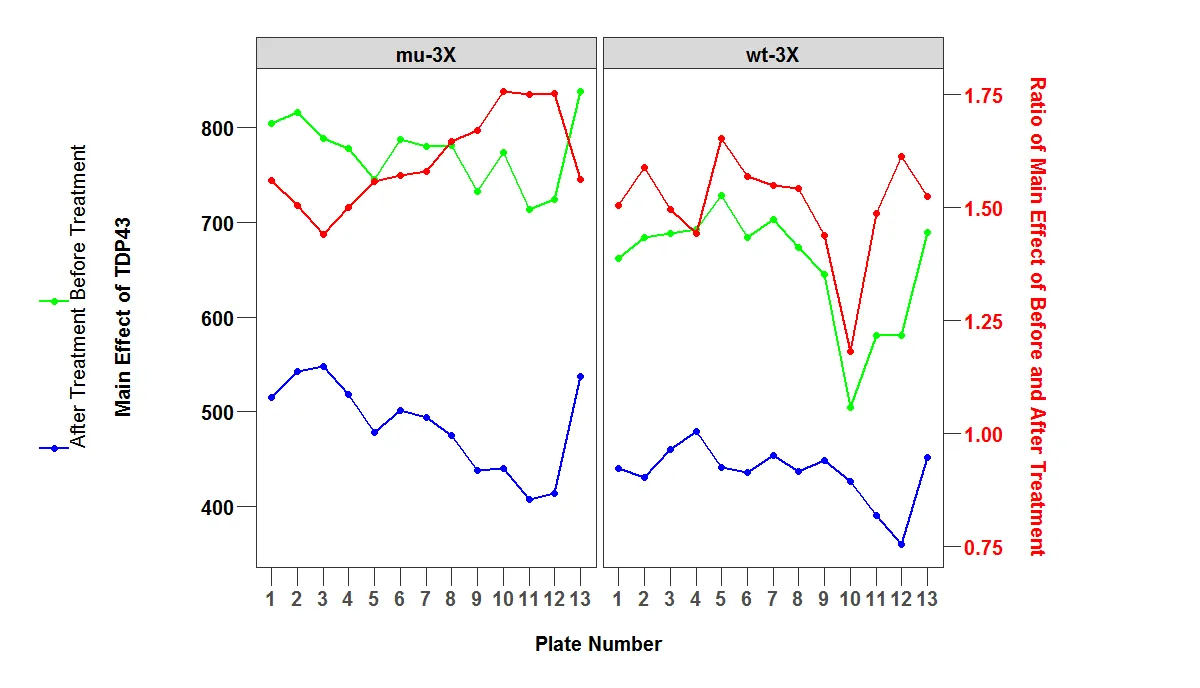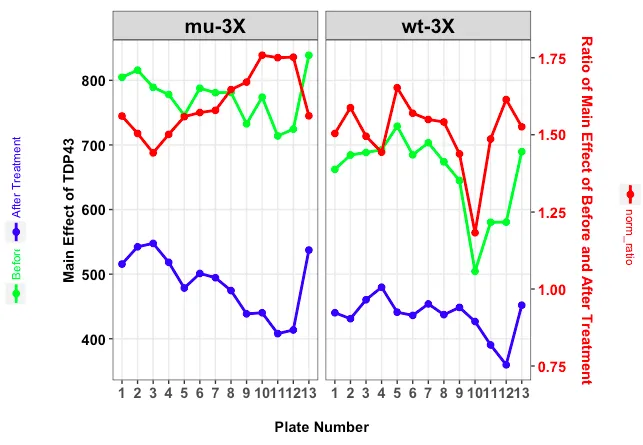我正在尝试在轴标题旁添加图例。我按照这个stackoverflow答案来绘制图表。
如何在两个y轴上添加图例?我希望左右两个Y轴上都有图例。在下面的图表中,右Y轴缺少图例符号。
同时,是否可能给文本赋予类似于图例中符号的唯一颜色。
同时,如何将图例键符号旋转到垂直位置?
我目前拥有的代码:
## install ggplot2 as follows:
# install.packages("devtools")
# devtools::install_github("hadley/ggplot2")
packageVersion('ggplot2')
# [1] ‘2.2.0.9000’
packageVersion('data.table')
# [1] ‘1.9.7’
# libraries
library(ggplot2)
library(data.table)
# data
df1 <- structure(list(plate_num = c(1L, 2L, 3L, 4L, 5L, 6L, 7L, 8L, 9L, 10L, 11L, 12L, 13L,
1L, 2L, 3L, 4L, 5L, 6L, 7L, 8L, 9L, 10L, 11L, 12L, 13L),
`Before Treatment` = c(662.253098499674, 684.416067929458, 688.284595300261,
692.532637075718, 728.988910632746, 684.708496732026,
703.390706806283, 673.920966688439, 644.945573770492, 504.423076923077,
580.263743455497, 580.563767168084, 689.6014445174, 804.740789473684,
815.792020928712, 789.234139960759, 778.087753765553, 745.777922926192,
787.762434554974, 780.828758169935, 781.265839320705, 732.683552631579,
773.964052287582, 713.941253263708, 724.459070072037, 838.899148657498),
`After Treatment` = c(440.251141552511, 431.039190071848, 460.349216710183, 479.798955613577,
441.123939986954, 436.17908496732, 453.938481675393, 437.237753102547,
448.52, 426.70925684485, 390.417539267016, 359.66121648136, 451.969796454366,
515.611842105263, 542.325703073904, 547.637671680837, 518.316306483301, 478.536903984324,
501.122382198953, 494.475816993464, 474.581319399086, 438.515789473684,
440.251633986928, 407.945822454308, 413.571054354944, 537.290111329404),
Ratio = c(1.50426208132996, 1.58782793698034, 1.49513580194398, 1.443380876455, 1.6525716347526,
1.56978754903694, 1.54952870311901, 1.54131467812749, 1.43794161636157, 1.18212358609901, 1.48626453756382,
1.61419619509676, 1.5257688675819, 1.5607492376201, 1.50424738548219,
1.44116115594897, 1.50118324280547, 1.55845435684647, 1.57199610821259,
1.57910403569899, 1.64622122149676, 1.67082593197148, 1.75800381540563,
1.75008840381905, 1.75171608951693, 1.56135229547),
grp = c("wt-3X", "wt-3X", "wt-3X", "wt-3X", "wt-3X", "wt-3X", "wt-3X", "wt-3X", "wt-3X", "wt-3X",
"wt-3X", "wt-3X", "wt-3X", "mu-3X", "mu-3X", "mu-3X", "mu-3X", "mu-3X", "mu-3X", "mu-3X",
"mu-3X", "mu-3X", "mu-3X", "mu-3X", "mu-3X", "mu-3X")),
.Names = c("plate_num", "Before Treatment", "After Treatment", "Ratio", "grp"),
row.names = c(NA, -26L), class = "data.frame")
max1 <- max(c(df1$`Before Treatment`, df1$`After Treatment`))
max2 <- max(df1$Ratio)
df1$norm_ratio <- df1$Ratio / (max2/max1)
df1 <- melt(df1, id = c("plate_num", 'grp'))
df1$plate_num <- factor(df1$plate_num, levels = 1:13, ordered = TRUE)
# plot
p <- ggplot(mapping = aes(x = plate_num, y = value, group = variable)) +
geom_line(data = subset(df1, variable %in% c('Before Treatment', 'After Treatment')), aes(color = variable), size = 1, show.legend = TRUE) +
geom_point(data = subset(df1, variable %in% c('Before Treatment', 'After Treatment')), aes(color = variable), size = 2, show.legend = TRUE) +
scale_color_manual(values = c('green', 'blue'), guide = 'legend') +
geom_line(data = subset(df1, variable %in% c('norm_ratio')), aes(color = variable), col = 'red', size = 1) +
geom_point(data = subset(df1, variable %in% c('norm_ratio')), aes(color = variable), col = 'red', size = 2) +
facet_wrap(~ grp) +
scale_y_continuous(sec.axis = sec_axis(trans = ~ . * (max2 / max1),
name = 'Ratio of Main Effect of Before and After Treatment\n')) +
theme_bw() +
theme(axis.text.x = element_text(size=15, face="bold", angle = 0, vjust = 1),
axis.title.x = element_text(size=15, face="bold"),
axis.text.y = element_text(size=15, face="bold", color = 'black'),
axis.text.y.right = element_text(size=15, face="bold", color = 'red'),
axis.title.y.right = element_text(size=15, face="bold", color = 'red'),
axis.title.y = element_text(size=15, face="bold"),
axis.ticks.length=unit(0.5,"cm"),
legend.position = c(-0.28, 0.4),
legend.direction = 'vertical',
legend.text = element_text(size = 15, angle = 90),
legend.key = element_rect(color = NA, fill = NA),
legend.key.width=unit(2,"line"),
legend.key.height=unit(2,"line"),
legend.title = element_blank(),
panel.grid.major = element_blank(),
panel.grid.minor = element_blank(),
strip.text.x = element_text(size=15, face="bold", color = "black", angle = 0),
plot.margin = unit(c(1,4,1,3), "cm")) +
ylab('Main Effect of TDP43\n\n\n') +
xlab('\nPlate Number')
print(p)


legend.direction = 'vertical',但仍然没有效果。 - Sathishvariable的对象。我认为它在问题中缺失了。 - Hack-Rmelt函数中,我可以使用variable.name参数来赋予用户定义的名称。 - Sathish